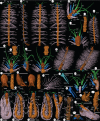A Silurian short-great-appendage arthropod
- PMID: 24452026
- PMCID: PMC3906945
- DOI: 10.1098/rspb.2013.2986
A Silurian short-great-appendage arthropod
Abstract
A new arthropod, Enalikter aphson gen. et sp. nov., is described from the Silurian (Wenlock Series) Herefordshire Lagerstätte of the UK. It belongs to the Megacheira (=short-great-appendage group), which is recognized here, for the first time, in strata younger than mid-Cambrian age. Discovery of this new Silurian taxon allows us to identify a Devonian megacheiran representative, Bundenbachiellus giganteus from the Hunsrück Slate of Germany. The phylogenetic position of megacheirans is controversial: they have been interpreted as stem chelicerates, or stem euarthropods, but when Enalikter and Bundenbachiellus are added to the most comprehensive morphological database available, a stem euarthropod position is supported. Enalikter represents the only fully three-dimensionally preserved stem-group euarthropod, it falls in the sister clade to the crown-group euarthropods, and it provides new insights surrounding the origin and early evolution of the euarthropods. Recognition of Enalikter and Bundenbachiellus as megacheirans indicates that this major arthropod group survived for nearly 100 Myr beyond the mid-Cambrian.
Keywords: Arthropoda; Herefordshire Lagerstätte; Leanchoiliida; Megacheira; Silurian; exceptional preservation.
Figures


Comment in
-
Enalikter aphson is more likely an annelid than an arthropod: a comment to Siveter et al. (2014).Proc Biol Sci. 2015 Apr 7;282(1804):20140946; discussion 20142663. doi: 10.1098/rspb.2014.0946. Proc Biol Sci. 2015. PMID: 25716792 Free PMC article. No abstract available.
References
-
- Erwin DH, LaFlamme M, Tweedt SM, Sperling EA, Pisani D, Peterson KJ. 2011. The Cambrian conundrum: early divergence and later ecological success in the early history of animals. Science 334, 1091–1096 (doi:10.1126/science.1206375) - DOI - PubMed
-
- Briggs DEG, Siveter DJ, Siveter DJ. 1996. Soft-bodied fossils from a Silurian volcaniclastic deposit. Nature 382, 248–250 (doi:10.1038/382248a0) - DOI
-
- Briggs DEG, Siveter DJ, Siveter DJ, Sutton MD. 2008. Virtual fossils from 425 million-year-old volcanic ash. Am. Sci. 96, 474–481 (doi:10.1511/2008.75.474) - DOI
-
- Orr PJ, Briggs DEG, Siveter DJ, Siveter DJ. 2000. Three-dimensional preservation of a non-biomineralised arthropod in concretions in Silurian volcaniclastics from Herefordshire, England. J. Geol. Soc. Lond. 157, 173–186 (doi:10.1144/jgs.157.1.173) - DOI
-
- Siveter DJ, Sutton MD, Briggs DEG, Siveter DJ. 2004. A Silurian sea spider. Nature 431, 978–980 (doi:10.1038/nature02928) - DOI - PubMed
Publication types
MeSH terms
LinkOut - more resources
Full Text Sources
Other Literature Sources

